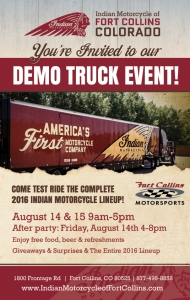Event planning can be both extremely stressful and extremely rewarding. There is nothing like seeing all of your hard work pay off after throwing a successful event where attendees (and the client) are happy, engaged and having a great time.
Although we don’t typically put on events at Old Town Media, we’ve been working with Indian Motorcycle of Fort Collins to plan a unique event. This coming weekend, August 14 & 15, The Indian Motorcycle Demo Truck will be at Indian Motorcycle of Fort Collins from 9am-5pm. Motorcycle enthusiasts will have the opportunity to admire and test ride the entire 2016 Indian Motorcycle lineup. As a special treat, Indian Motorcycle of Fort Collins is hosting an after party on-site on Friday from 4pm-8pm.
While it might sound simple and completely straight forward on paper, there actually is a lot that goes into planning an event like this. So if you’re planning an upcoming party (by upcoming, I mean start planning for your holiday party) here are some practical tips & things to consider:
1. Plan Early
I recommend you start planning at least 6 weeks before the event date. Things to consider before even beginning: you need to decide if your event is going to be open to the public or RSVP only. You need to give your guests enough notification ahead of time to RSVP and get the date on their calendars and plan accordingly. In terms of holiday parties, remember this is a very busy time for people so if you want them to attend your party – plan early!
2. Food, Drink and Entertainment
Most people come to parties or events to socialize, drink and eat. Will your event be fully catered? If so, it is essential to start researching catering companies and costs early on. The same thing goes for drinks. Are you going to provide wine and beer? You’ll need to make sure that this is monitored if you are hosting a public event to avoid any legal issues and so things don’t get out of hand.
If you plan on having entertainment at your event, it is a good idea to set a budget and get that locked in earlier rather than later. If live entertainment is not in the budget, a great alternative is a playlist and quality speakers to give some background noise while your guests enjoy themselves. No one likes silent parties!
3. Marketing, Advertising and Invitations
How will you get the word out about your event? Email newsletters, press releases, social media posting, mailed invitations, print material and a landing page on your website are all great ways to spread the word and encourage maximum attendance. For social media, create an event on Facebook, start posting early and encourage your Facebook fans to spread the news about your event! Remember to use your cover photo (which is essentially free advertising) to promote your event!
Below is an example of the email newsletter that went out announcing the Indian Demo Truck Event:

We adapted this digital piece to make hard-copy postcards, which were handed out to customers at Indian Motorcycle of Fort Collins and Fort Collins Motorsports along with local businesses around town, geared towards engaging our target audience.
4. Logistics
Even after putting on hundreds of events and when you feel 100% prepared, it is always important to take a step back and think about the logistics of your event. How big is your venue? Will all of your guests be able to comfortably mingle and enjoy themselves? Will guests need guidance or a schedule for your event? Doing a walk through of how your event will flow and be set up is crucial to include in the event planning process.
5. Being Prepared for the Unexpected
The thing is, stuff happens. You need to be prepared for unplanned situations as best as possible and try to have a back up plan. What if you have more attendees than planned and food runs out? What if the caterer shows up late? What if the taps to the kegs are broken and your guests cannot enjoy beer? Things like this happens and when you are prepared with a back up plan, it makes things a lot less stressful for both you and your guests!
6. Have Realistic Expectations
If your event is open to the public, it is hard to gauge how many people will attend and what will constitute as a successful event. Try to set a realistic goal of attendance and outcome. If your goal is to spread awareness about your new business, I would gauge the event by attendance and set an obtainable goal.
7. Manage and Enjoy the Event!
Even though you are planning the event and will be technically working during the event, don’t forget to enjoy yourself! You are a direct representation of your business and if things go haywire, keep calm and try your best to keep a smile on your face.
Most of the time, guests are too busy in their own world to notice that the water pitcher has no ice in it, or the food is almost about to run out. Make sure to keep an eye on the small details such as this, but do so casually and still have fun! If anything truly bad happens, take it as a learning lesson and make note of it for next time.
8. Evaluate
Try to do a head count at your event to see how many guests attended. You’ll be able to tell pretty quickly the overarching feel of the event and if your guests enjoyed themselves. If the event allows, make sure to thank all of your guests for coming and keep them informed of any additional upcoming events.
Take note of things that went well and things you can improve on for next time. Whether your event was a huge success or an epic failure, there is always room for learning and improvement.
